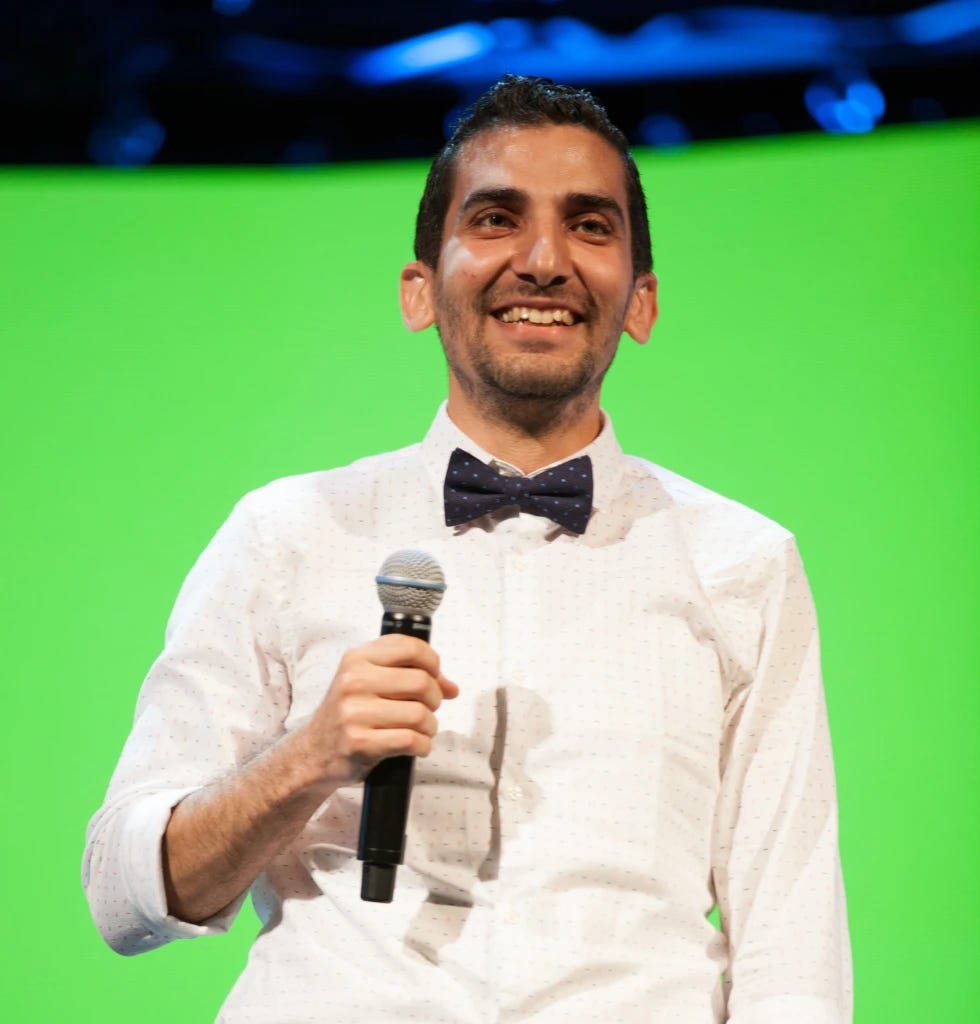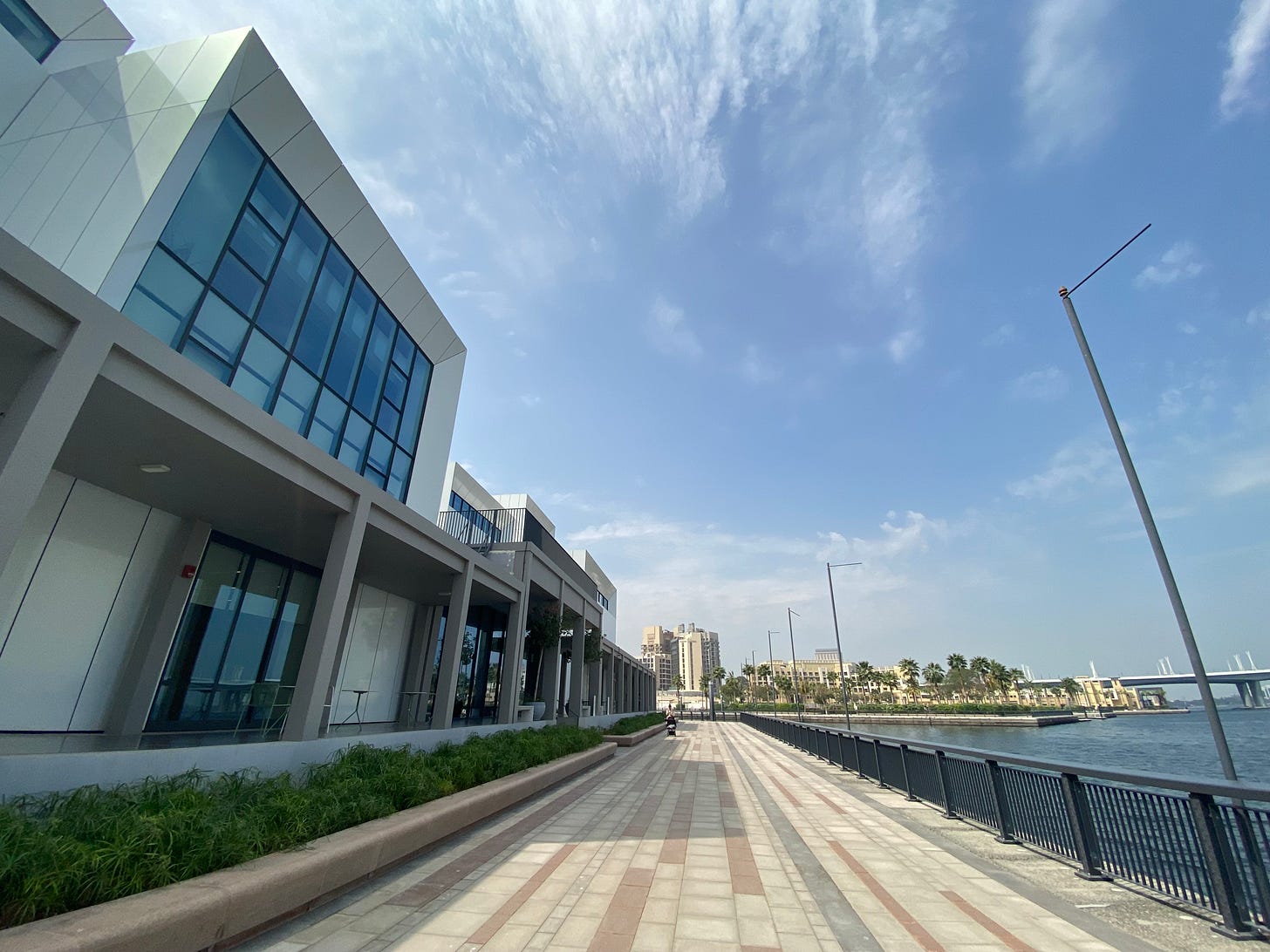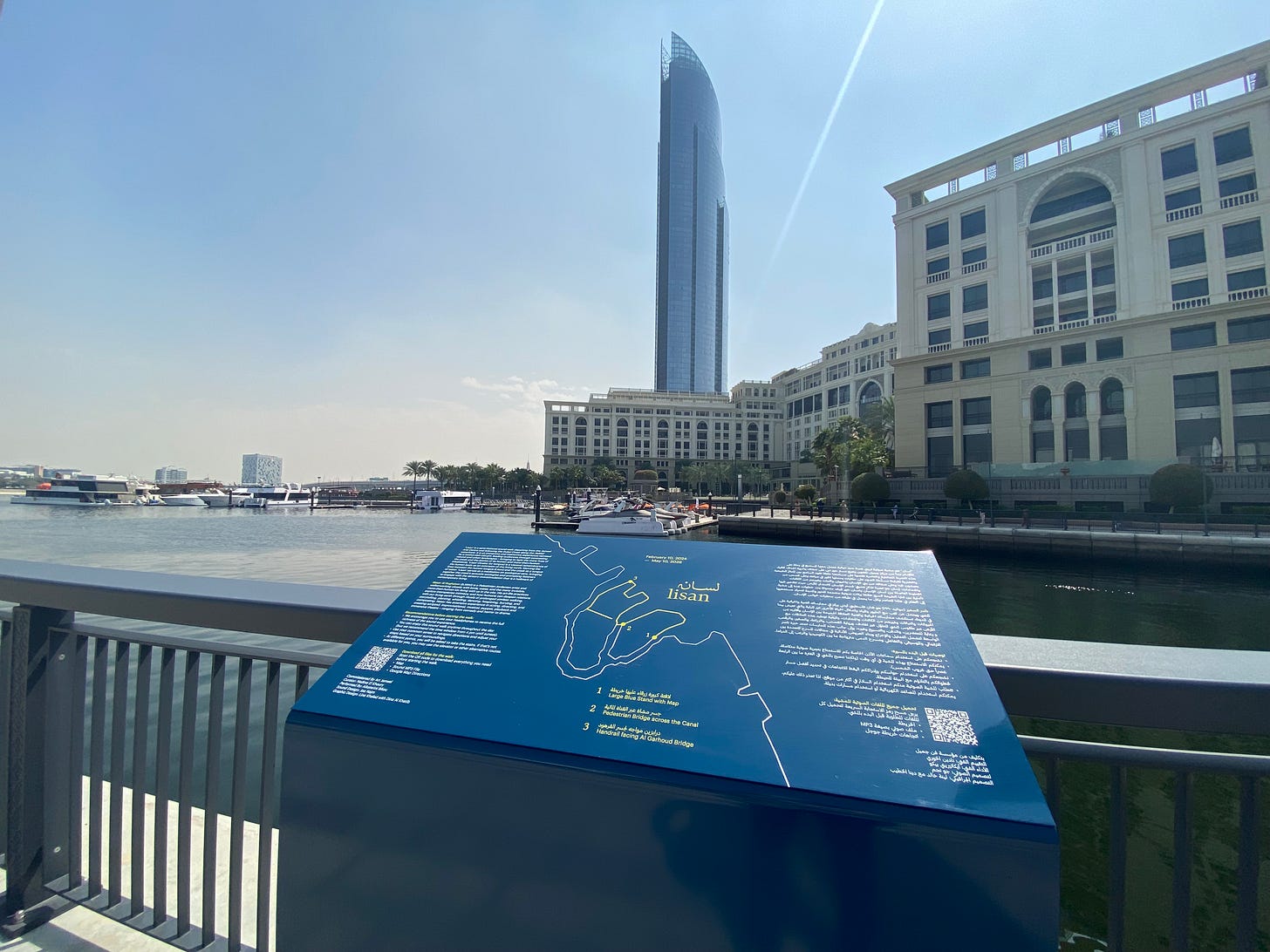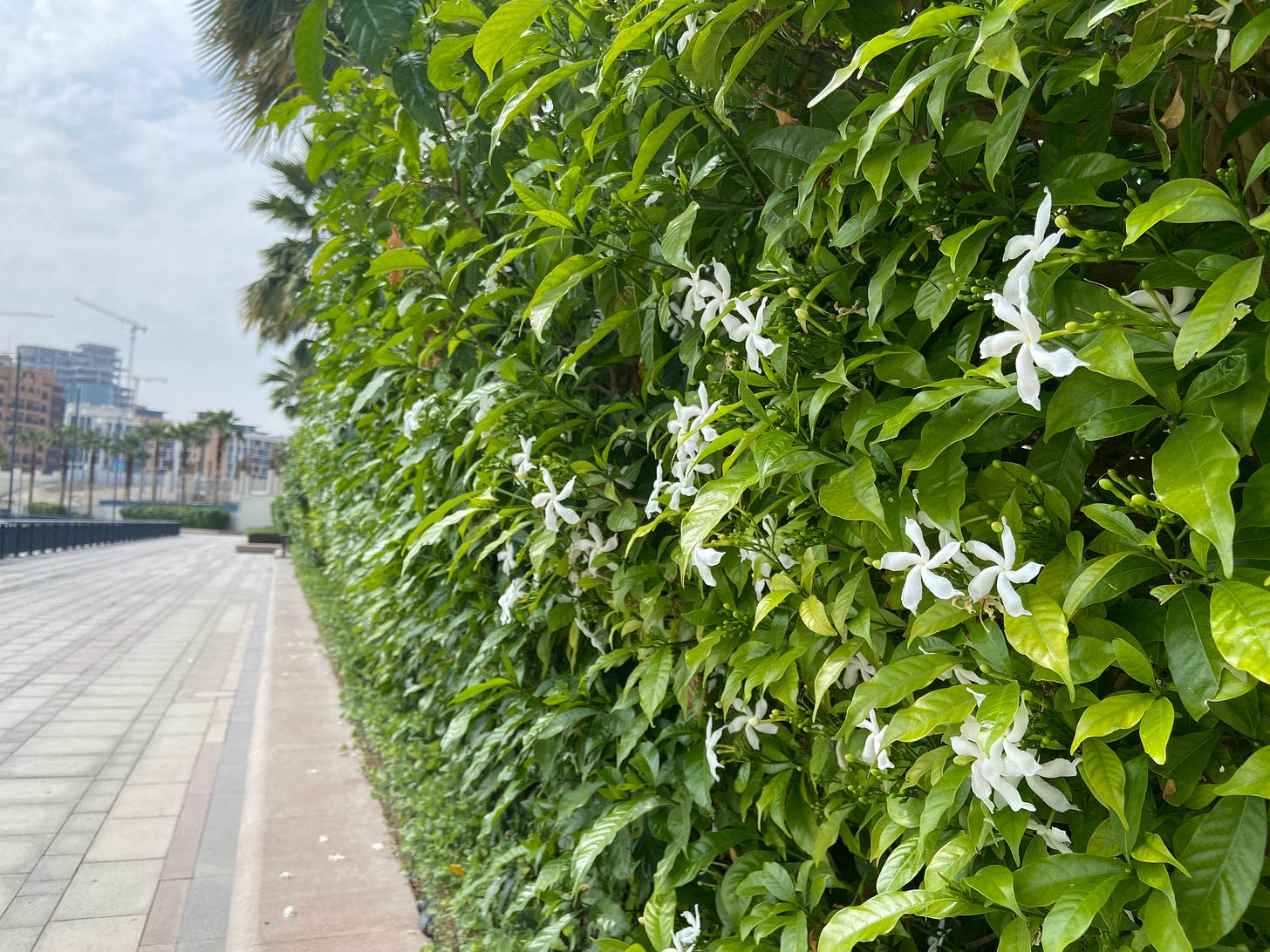A Sound Walk in Dubai
Reflections of an immersive artwork about urban belonging

Dear City Person,
In this free weekly newsletter, I have the first post of each month feature artwork, conversations, academic or non-academic readings, podcast listens, or other media about urban belonging.
I encourage you to reach out to me, whether privately by replying to this email or publicly commenting on Substack, if you ever run into anything about connecting with people and places that you would like me to cover in a future newsletter.
If you are new, check out the About page linked here if you haven’t already and click here to see an archive of previous posts. If you are viewing this from the Substack app and have not already subscribed, you may do so by clicking on the button below:
For today’s post, I will be sharing my experience with an interactive art exhibit in Art Jameel called Lisan Sound Walk by Dubai-based Palestinian-Jordanian theater artist and walker Naser Al Sughaiyer. It involves listening to a pre-recorded audio file of a 12-year old girl who guides the listener in a 30-minute walk by the Art Jameel side of the Dubai Creek. It blends storytelling, psychosomatic and meditative practices, environmental awareness, and history to help listeners connect with the Creek and the human and non-human beings who inhabit it (including those “built” by humans).
Let me know in your email replies or Substack comments if you have already visited the exhibit or plan to!
Click here for more information about the Sound Walk and here is more on Art Jameel itself. Below are some considerations to keep in mind before you visit:
Be sure to bring earphones or headphones with you and download the audio file in the bottom of the webpage linked here. The same link also has a Google map of the walk.
While one can engage in the Sound Walk at any time of day until May 2026, it is recommended to visit from 4pm till sunset as there is limited shade. Since I didn’t have a chance to visit in the weekend and I I tend to start work later in the day but woke up a bit too late on the day of, I ended up visiting by 12pm. The sky was unfortunately hazy but a few clouds came afterwards before it cleared up. Luckily, there was a cool enough breeze by the water but I wish that I brought my hat and applied sunscreen. But as you will see later in my post, it was still a rewarding enough experience for me and I do look forward to visiting again to see how my experience changes.
The walk is mostly wheelchair accessible except for the last 5 minutes which requires using the stairs (see photos below). Naser mentioned to me though that wheelchair users can ask reception at Art Jameel for alternative routes before starting the walk (but make sure that you visit within their working hours).
I believe that blind visitors may get to enjoy the experience as the audio narrative is detailed enough to give a sense of where things are and an idea of what they look like and the psychosomatic practices are also engaging. But I do wish that more touch cues were incorporated to make it even more accessible for this demographic.
No transcript is provided in the link for deaf visitors to download as an alternative to the sound recording (and I forgot to ask Naser about this but I will write a brief update in my next post next week if I learn more about this). Also some of the prompts the narrator shares involves focusing on sounds but there are other prompts that do incorporate other senses.
I initially found it difficult to locate the starting point. Although a google map is provided of each point, it was not showing where I was in relation to each point but eventually I was able to locate the blue sign that has the map and description of the Sound Walk (see photo later in this post). I also got a little lost toward the end after I walked up the last set of stairs because there were parts blocked by construction but I was able to get back to my parked car. I would recommend asking Art Jameel beforehand about the starting point and last steps if you visit within their working hours.
Before I share my reflections of the walk, I want to provide some context about how I know Naser and the process behind his creation.

Naser is one of the online friends I have made during the pandemic shutdowns. I was introduced to him through a now no longer publicly active virtual space he used to lead called The Human Lab which hosted interactive virtual sessions that would encourage participants to meaningfully connect. While I had only attended it once, the experience was still a powerful enough balm for me during the shutdowns and I admired (perhaps envied) Naser’s skillful yet down to earth approach in facilitating large groups of people.
I followed The Human Lab on Instagram and found it refreshing to see content about social and emotional health in layperson Palestinian Arabic dialect alongside English presented in a way that was relevant to Middle East/North Africa region. I later had more one-to-one conversations with Naser via Clubhouse, where he also facilitated deep conversations, before the app got too messy and I left it. He later decided to shift his focus away from virtual spaces. While we only talk occasionally, each conversation always leaves me with lots to think about on decolonization, belonging, and connection.
I especially love hearing his insights from his walks in parts of Dubai that are often under-appreciated. So as you can imagine, I was quite thrilled when Naser told me about his new exhibit which involves walking! While I missed the opening event, Naser was generous to share with me what he wrote to prepare for it. He shared it with me on WhatsApp after I completed my walk and added the following:
“There are so many other details. These are just tiny hints. The story is layered and is received differently by different walkers/listeners. Rather than influencing you and telling you all details, codes, symbols and layers, I’d rather trust you/your body/senses and to trust listeners/walkers to receive the specific type and dose of medicine they need from the story/walk at whatever time(s)pace they are at/in in their moment/s of receiving this. The medicine is not only intending to soothe, heal or stabilize, but to also trouble the mind and body and the ways we are conditioned to define storytelling (as the hero’s journey) and healing (as comfort/stability/purity/cleansing, etc).”
I believe I cannot do him justice by paraphrasing what inspired his process so I am sharing parts of it here below before writing about my solo experience of the walk. I also hope that by me sharing his words, you get a glimpse into his wonderful personality.
“I greet you with Marhaba, which is the Arabic word for “spaciousness”. I greet you with spaciousness. With the vastness of the desert, the wide skies, the endless flocks of seagulls flying above us, the continuous flow of the creek, and the seas and the oceans that surround us.
I also want to greet you with narrowness and tightness, in the space between my tongue and the roof of my mouth as I say Marhaba. I greet you in the wooden cones above us where birds shelter and nest. In the cracks of the tiles/concrete beneath our feet. In a closed carton box where a Gazan parent hide their baby for a little bit of warmth. I greet you in the pores of the soil, and in the empty space between your toes, where many strange things happen out of sight in the shadows.
Speaking of happening in the shadows. Two weeks ago, during the full moon night, I attempted for the first time to continuously walk a full circle around every inch of the Dubai Creek’s edges and shores. The total distance of this circle is around 70 Km. That’s 15 hours of walking. In non-linear distance, this is about 91,863 steps and oscillations in my feet, arms, muscle tissues, bones, internal organs, gut bacteria, fluids, and the oscillation in many other non-human lives hiding in the cracks of my constructed notions of humanity, of this separate, stable, pure, and impermeable human.
My walk started from the edge of Al Jaddaf Waterfront by Al Garhoud Bridge, to Festival city, Dubai Creek Harbor, circling around Ras Al Khor Sanctuary, to D3’s Design district, to Business Bay, through Al Jumeirah until the end of the creek in the sea. And then not ending there but crossing to the other side of the creek and circling back to the other end of the creek at Port Rashid…. I left at 4:30 pm from here and walked all night. But after 13 hours, at 5:30 am, I was not able to continue walking. I reached my limits and I was almost about to crawl on the ground. I failed to complete the circle… But that’s not the only time I was gifted failure.
Every day before that, I had failed. Prior to this attempt and over the last few years, I have failed again and again.
In the next few minutes, I would love to share with you a bit about “walking”, what it means to me, and things that I’ve never shared with anyone, and then afterwards I’ll speak about the Lisan sound walk. It’s a bit contradictory though that I talk about walking while we are seated. Nevertheless, I am gonna try to walk with your mind and with your curiosity. If this doesn’t work, I’ll stop and we’ll just go on the sound walk. This would be our exit strategy from listening to Naser.
Over the last few years, I have aimlessly walked long repeated distances through the urban veins of the city, merely guided by the creek, the birds, and a persistent impulse to descend and lose my way. I walked so much until my off-white colored shoes became waaaaay off white. Those unproductive, time-wasting walks intensified over the last two years happening every other day with each lasting up to 7 hours. This happened after a period of having been grappling for a long time with feelings of despair and hopelessness, isolating in my room.
These walks developed into this not-so interesting practice of walking, which has certain qualities to it that I slowly began to notice over the years. I’ll briefly mention 4 things to describe them:
These walks were aimless, with no purpose or pre-set end point.
They were prolonged, happening over a relatively longer span of time.
They were boring repetitions of slow walks where almost “nothing” exciting happened. Wanderings, repeated on the same paths again and again.
And They happened on unexpected paths of both walkable ones and also on others where walking was not so friendly, in the shadows and in between the cracks of the city.
Those random prolonged walks almost resembled the prolonged scrolling that our fingers and bodies resolve to and shelter in on TikTok, insta, facebook, youtube… after a long and tiring day. And just like fingers scroll through phone screens, these random and prolonged walks were somehow also the feet scrolling over the land to escape the normalcy of everyday life. This escape was not just from life, but also to life. Longing for other ways of being that my body and feet were trying to glimpse and gesture towards while walking.
The more I randomly walked, the more I could see the algorithmic webs of the earth and the city we are part of: its organs, networks, movements, rhythms, seasons, shapes, textures, smells, tastes, sounds and its many visible and invisible human/non-human bodies who inhabit and make up this city. This wider algorithmic life is not in contrast with social media’s algorithmic web. On the contrary it embraces it and includes as one out of many ways the world moves and worlds itself. Social media’s algorithms move in such a way to perfect the creation of self-reinforcing, self-gratifying eco chambers where already-existing ways of being/thinking/imagining are hyper-validated in epistemic bubbles… This wider algorithmic web of life that we inhabit (and are being moved by right here right now as we commune without internet) shows you suggested posts, postures and movements of not only what you already know, but also what conflicts and troubles your current knowing and being. When we walk by randomly scrolling our feet into the ground, the city gifts us complexity and paradox within and beyond our current capacity to sense, receive, perceive and process. Isn’t it amazing how we tell ourselves: “If you scroll through your social media just a little bit longer, you may be able to find something interesting”. And we are right, yes if you scroll your feet randomly, patiently and slowly through the city, you may as well find something interesting.
When I walk, I don’t know why and where I am going. I walk holding my hopes, joys, despairs, desires, pains, enchantments, disenchantments, entitlements and privileges consuming, processing and spreading them over land, shedding blood, sweat and tears into water, blowing sighs into the air, and burying and composting my dying selves in the soil of the earth.
This unproductive, aimless and primordial walking extends beyond the obvious activity of moving feet, staying fit, and transporting bodies to fixed destinations. Walking is a fugitive movement that spills over the edge of our modern habits of being and blurs the lines between feet and land. The more we walk through the city, the clearer we can see our-selves entangled with the city, and that somewhat we are the city (I am Dubai!). And as we continue to witness our cities extending their techno-urban outfits and layering our body-landscapes and desertscapes, walking is increasingly becoming a silent longing-to-be and an inevitable movement. It’s a ceremony of reclamation of our body-city organs scattered all over the stages of modernity we are catwalking every day.
This new and ancient technology of walking that our Bedouin ancestors of this desert have embodied as a way of being through harsh environment has the potential to open new portals and capacities for (un)learning, composting, hospicing, renewal, dying and birth. It can help us reclaim atrophied senses, regrow severed limbs, reactivate internal compasses, compost collective shadows, and rewild modern bodies situated linearly within our ambitious metropoles.
Now this Lisan sound walk is a gift by the (in)visible bodies, agencies and stories (feet, sneakers, water, ants, concrete, flesh, bones, concrete, soil, sun, clouds, rain, winds, birds, airplanes, trees, leaves, blood, sweat, tears, the Jameel Centre, its people, the library, the gardens and more and less…) that all had to metabolize and surrender parts of their forms spilling over to and becoming this digital creature called MP3 that you will download to your phone and listen to shortly. The organs and the content of this sound walk were all woven from human and more-than-human residents and migrant guests here in Al Jaddaf.
The complex process of writing, creating, recording and weaving of this sound walk happened in relation to the immediate surrounding relations and what has been moving around Al Jaddaf Waterfront. This sound walk is a living being, a relational being, just like us weaving not only narratives and stories, but also bodies, intensities, spacetimes, movements and steps. Most of the sounds in this sound walk come from Al Jaddaf lands here and not from pre-packaged or extracted sound bites. We also recorded this not in a closed studio, but here outdoors in Al Jaddaf. What you’ll listen to was recorded over one continuous take, following Kat doing her own thing of embodying the 12-year old lead character of the story (…)
The story threads and sounds showed up when we least were searching or thinking of them. When I am walking, resting or sleeping by the side of the creek, they come. The story moves at different layers. It is coded with symbols and dream-like gestures, sometimes with words and puzzles, and other times coded in movement and space. The body and the mind do this not as a nice thing to do, but as a necessary way to honor entangled relations with the land, and to archive stories sensorially in bodies and in the land. This story continues to morph and shapeshfit depending on who is listening to it. It has different dance moves and will dance differently with each of you.
We invite you to walk this sound walk with the pace and curiosity of an excited and frustrated toddler learning how to walk for the first time. We encourage you to risk being changed, lost, and released in ways that are yet to be imagined and can only be unlocked at your time(s)pace, with your body and feet walking with and as part of the land.
Alright, are we ready to walk?”
The word “Lisan” means “tongue” in Arabic. The map pictured above (which is also the starting point of the walk) shows how this does not only literally embody one of the mediums in which the Sound Walk is delivered, but also reveals the shape of the creek itself. I noticed this before reading the description.
I love how the opening of the audio file gave credit to not only fellow humans who supported its creation, but also the fellow non-human beings who are part of the creek and were also part of the recording. I found it interesting how the fictional character had an Arabic name and pronounced local Arabic names of places with a quintessential English accent. I wonder if this was intentional to give a tiny glimpse into the transcultural diversity of what it means to reside in Dubai, particularly in a locally significant setting like the creek that was key to turning Dubai into an important global trading hub.
I was initially annoyed by the weather and the sounds of repairs/construction nearby but as I began and progressed in the walk, I came to appreciate them as sounds of fellow non-human kin that were part of the creek at that moment in time. When the narrator directed me to listen to the sounds of the creek’s waters, I initially had difficulty doing so. I started to wonder if my ability to tune in “atrophied” as the narrator said from the reality of living in an overstimulating urban environment. Later, I focused on the sounds and sight of the waves lapping the boats across from me. I also appreciated how the waves closer to me danced into different shapes that I would not have noticed had I only mindlessly passed by them.
I was amused by how a plane showed up in the distance at the very second the narrator directed me to notice the planes passing by every 2 minutes! There were more moments when I experienced such child-like amusement. One example was when I was directed to “stomp” away existential anxiety while going up the first set of stairs (which has an elevator alternative)/crossing the bridge. Another, which I initially found strange before coming to enjoy it, was when I was asked to move my tongue inside my closed mouth in a counter-clockwise direction until I reach the number of my age while noticing how my saliva is gathering, mirroring the lapping of the creek’s waters.
I especially loved deeply “breathing in the scent of the creek” with my open mouth. It reminded me of how one of my past psychotherapy clients told me that every city has a unique smell. I don’t think I ever came to understand that until doing this practice at the Sound Walk. I also enjoyed seeing the “pinwheel flowers” which were still in bloom in a part of the walk and loved that the audio acknowledged their presence too. I found a few that looked like they had recently fallen and decided to pick those up so that I can press them and use them in a collage. I will update in a future post if and when I do the latter.
But the audio was not all emotionally “flowery” either. It did bring up the urgency of facing the emotional and spiritual consequences of environmental destruction. This was especially the case towards the end where the narrator asks us to “run and don’t stop” as she said the waters of the creek are now flooding us as mother nature has been going through repeat contractions and can no longer hold us. Coincidentally, in that very moment I noticed the winds around me get stronger adding to the impact of the message.
I chuckled when I reached the last staircase shown in the photo below and the narrator said that we need to “climb up and beyond the edges of what we know” and that there is no other way but to “zigzag your way through it, there is on linear straight line to a place of arrival. We have to humbly lose our way and to shed our blinding arrogance.” Indeed, beyond the first set, there was literally no way but for me to zigzag my way up and I could not see what lay beyond the end point from the base of the stairs.
Overall, I enjoyed having a full body experience to reconnect with the creek. I also loved how the audio did not see nature and built environment as separate things. As you may have noticed in my post, it described things like bridges, planes, cars, and the man-made expansion of the creek as parts of nature and as fellow non-human kin alongside the birds and pin-wheel flowers. I appreciated how it held the multitude of human humans and sounds, not all of which are “peaceful.” Perhaps connecting with people, animals, plants, and places is not possible without the ability to hold their multitudes.
I would love to read your thoughts on my reflections. If you do get to visit, I would love to learn about your experience of the Sound Walk. Let me know if you prefer to keep your response private or if you would like it to be featured in a future post.
In next week’s newsletter, I will write about my experience using conversational cards with friends and family. Scroll down to the end of my second post linked here where I mention the ones I have used so far.
Do reach out to me if you have used conversational cards in the past and what that was like for you or if you are thinking about trying them out and why do you want to do so. Let me know if you want me to feature your share in a future newsletter and if you would want me to mention you by name otherwise I can keep your response private.








Like Rita, I listened without visiting too. Interesting thoughts and images conjured up through a soundscape, a different experience from actually being there. Thank you. Xx
Thank you again Reema for being a guest and a host of the Lisan sound walk. I really enjoyed reading about your experience and learning a lot with you. Looking forward to next posts and city wanderings. Shokran kteer and hayyaki! :)